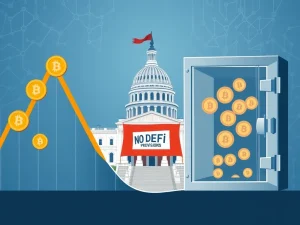Stablecoins: Unlocking a New Era as JPMorgan & Citigroup Make Strategic Entry

The financial world is witnessing a pivotal shift. For years, the traditional banking sector viewed cryptocurrencies with skepticism, if not outright disdain. Yet, a remarkable transformation is underway as giants of legacy finance, including JPMorgan and Citigroup, are now actively exploring and entering the stablecoins market. This isn’t just a fleeting interest; it’s a strategic embrace of digital assets that signals a new era for global finance.
The Great Awakening: Why Legacy Finance is Embracing Stablecoins
The move by major financial institutions into the stablecoins space is not coincidental. It’s a response to evolving market dynamics, technological advancements, and a clearer regulatory landscape. These institutions recognize the inherent value proposition of stablecoins – their ability to offer the speed and efficiency of blockchain technology while maintaining price stability by being pegged to fiat currencies like the US dollar. This dual benefit makes them an attractive proposition for modern financial operations.
JPMorgan Stablecoin: A Giant’s Strategic Leap
JPMorgan Chase, the largest bank in the United States, has made its intentions clear regarding its involvement in the stablecoin ecosystem. CEO Jamie Dimon recently affirmed the bank’s commitment to exploring this burgeoning sector. Dimon highlighted competition from fintech companies as a significant driver, noting that these innovators are increasingly replicating features traditionally offered by banks. JPMorgan’s approach involves a dual strategy: engagement with existing stablecoins and the continued development of its proprietary ‘JPMorgan deposit coin.’ While Dimon acknowledged the reality of stablecoins, he also raised a pertinent question about their utility compared to direct payment systems, indicating a nuanced but firm commitment to understanding and participating in this evolving financial frontier. The bank’s institutional offering, JPMorgan deposit coin, is already a proof-of-concept token on a public blockchain, targeting cash payments and settlements for its institutional clientele. The development of a specific JPMorgan stablecoin or deposit coin demonstrates a forward-thinking approach to digital payments.
Citigroup Stablecoin: Charting a Course for Digital Payments
Not to be outdone, Citigroup is also actively charting its course into the digital asset realm. Citigroup CEO Jane Fraser confirmed the bank’s consideration of issuing a Citigroup stablecoin to facilitate digital payments. Fraser emphasized the broader ‘tokenized deposit space’ as a key area of activity for the bank, viewing it as a significant opportunity. This collective interest isn’t new; recent reports indicated that a consortium of major banks, including JPMorgan, Bank of America, Citigroup, and Wells Fargo, were discussing a joint stablecoin initiative. This collaborative exploration underscores the systemic interest in leveraging stablecoin technology for improved financial infrastructure. The potential for a Citigroup stablecoin highlights the widespread interest among financial giants.
Understanding Bank Stablecoins: What’s the Difference?
As traditional banks venture into this domain, it’s crucial to differentiate between various types of bank stablecoins and their implications. While standard stablecoins like USDT or USDC are issued by private entities and backed by reserves, bank-issued stablecoins or tokenized deposits offer a direct link to the regulated banking system.
- JPMorgan Deposit Coin: This is JPMorgan’s proprietary token, designed for institutional clients for immediate cash payments and settlements on a public blockchain. It represents a tokenized deposit rather than a standalone stablecoin in the traditional sense, providing a regulated, bank-backed digital asset.
- Potential Citi Stablecoin: While details are still emerging, Citigroup’s consideration of a stablecoin issuance would likely aim to streamline digital payments, potentially leveraging their existing banking infrastructure and regulatory compliance.
- Joint Bank Stablecoin Initiatives: A collaborative stablecoin among multiple banks could standardize interbank settlements and corporate payments, offering efficiency gains across the financial ecosystem.
These initiatives highlight a move towards ‘on-chain’ traditional finance, bridging the gap between established financial services and the efficiency of blockchain technology, fundamentally changing how bank stablecoins operate within the broader financial system.
Navigating Crypto Regulation: The GENIUS Act’s Impact
A significant catalyst for this newfound banking interest is the improving regulatory environment in the United States. The passage of the GENIUS Act through the Senate, now under consideration in the House of Representatives, signals a crucial step towards establishing a clear framework for stablecoins and their issuers. This legislative progress is vital for institutional adoption, as regulatory certainty reduces risk and provides a clearer operational pathway. US President Donald Trump’s recent call for the GENIUS Act’s passage during ‘Crypto Week’ further underscores the bipartisan recognition of stablecoins’ importance. The Act is seen as legitimizing stablecoins for global institutional adoption, potentially enhancing the dollar’s dominance worldwide by making it easier and faster to transact digitally across borders. Clearer crypto regulation is a game-changer for mainstream adoption.
The Future of Stablecoins: What’s Next for the Market?
The stablecoin market is experiencing robust growth, reflecting its increasing utility and acceptance. According to DefiLlama, the current stablecoin market capitalization stands at an impressive $258 billion, marking a significant 58% increase from $163.3 billion just months prior, on July 16, 2024. This growth trajectory is fueled by their recognized benefits:
- Ease of Use: Stablecoins simplify digital transactions.
- Speed: Transactions settle much faster than traditional banking methods.
- Simplicity: Their design makes them accessible for a wide range of users and businesses.
- Global Reach: They facilitate seamless cross-border payments.
Many observers now consider stablecoins to be crypto’s first mainstream use case, adopted by businesses and individuals globally. As major banks like JPMorgan and Citigroup enter this space, their participation is expected to bring increased liquidity, institutional trust, and potentially new use cases, further solidifying stablecoins’ role in the future of finance. While challenges like regulatory nuances and competition remain, the momentum is clearly shifting towards a more integrated financial ecosystem where digital assets play a central role.
The entry of financial titans like JPMorgan and Citigroup into the stablecoin arena marks a watershed moment for both traditional finance and the broader cryptocurrency landscape. It signifies not just an acknowledgment but a strategic embrace of digital assets, driven by competitive pressures, technological advancements, and evolving regulatory clarity. As stablecoins continue to gain traction as a vital bridge between fiat and crypto, their integration into legacy financial systems promises to unlock unprecedented efficiencies and reshape the future of payments and settlements globally. This strategic pivot ensures that stablecoins are not just a niche crypto product, but an integral component of the evolving global financial infrastructure.









